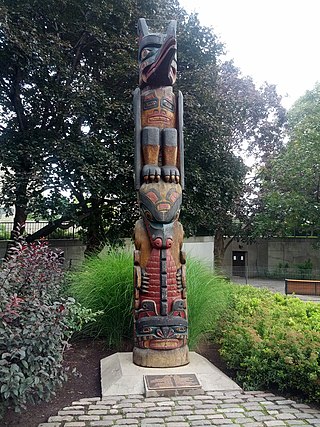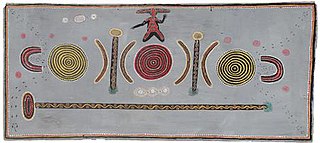
The Dreaming, also referred to as Dreamtime, is a term devised by early anthropologists to refer to a religio-cultural worldview attributed to Australian Aboriginal beliefs. It was originally used by Francis Gillen, quickly adopted by his colleague Sir Baldwin Spencer and thereafter popularised by A. P. Elkin, who, however, later revised his views.
The Wawalag sisters, also written as WauwalukWawilakWaggilak, Wagilag, or Wawalik, are ancestral creator beings whose story is part of widespread sacred rituals in the Aboriginal culture from Arnhem land, Northern Territory, Australia.

A totem is a spirit being, sacred object, or symbol that serves as an emblem of a group of people, such as a family, clan, lineage, or tribe, such as in the Anishinaabe clan system.

Hermannsburg, also known as Ntaria, is an Aboriginal community in Ljirapinta Ward of the MacDonnell Shire in the Northern Territory of Australia, 125 kilometres (78 mi); west southwest of Alice Springs, on the Finke River, in the traditional lands of the Western Arrarnta people.
Theodor George Henry Strehlow was an Australian anthropologist and linguist. He notably studied the Arrernte Aboriginal Australians and their language in Central Australia.
Carl Friedrich Theodor Strehlow was an anthropologist, linguist and genealogist who served on two Lutheran missions in remote parts of Australia from May 1892 to October 1922. He was at Killalpaninna Mission in northern South Australia, from 1892 to 1894, and then Hermannsburg, 80 miles (130 km) west of Alice Springs, from 1894 to 1922. Strehlow was assisted by his wife Friederike, who played a central role in reducing the high infant mortality which threatened Aboriginal communities all over Australia after the onset of white settlement.
Papunya Tula, registered as Papunya Tula Artists Pty Ltd, is an artist cooperative formed in 1972 in Papunya, Northern Territory, owned and operated by Aboriginal people from the Western Desert of Australia. The group is known for its innovative work with the Western Desert Art Movement, popularly referred to as dot painting. Credited with bringing contemporary Aboriginal art to world attention, its artists inspired many other Australian Aboriginal artists and styles.

The Arrerntepeople, sometimes referred to as the Aranda, Arunta or Arrarnta, are a group of Aboriginal Australian peoples who live in the Arrernte lands, at Mparntwe and surrounding areas of the Central Australia region of the Northern Territory. Many still speak one of the various Arrernte dialects. Some Arrernte live in other areas far from their homeland, including the major Australian cities and overseas.
In Australian Aboriginal religion and mythology, Ankotarinja is the first man, also called the Dreaming Man. His myth belonged to a small band of Arrernte people, known as the Ngala-Mbitjana people. They were heirs to Ankotarinja's exploits at the time of the Dreaming, performing his ceremonies and initiating their young iliara (novice) into his totemic lodge. They kept alive the memory of his world-creating endeavors. Ankotarinja's birthplace is a creek-bed near Ankota.
The Elementary Forms of Religious Life, published by the French sociologist Émile Durkheim in 1912, is a book that analyzes religion as a social phenomenon. Durkheim attributes the development of religion to the emotional security attained through communal living. His study of totemic societies in Australia led to a conclusion that the animal or plant that each clan worshipped as a sacred power was in fact that society itself. Halfway through the text, Durkheim asks, "So if [the totem animal] is at once the symbol of the god and of the society, is that not because the god and the society are only one?"
Ntaria Choir, formerly known as Ntaria Ladies Choir, Hermannsburg Ladies Choir, Hermannsburg Choir, and various other names, is a choir of Australian Aboriginal people from Hermannsburg in Central Australia. The members of the choir are Arrernte people from the area and they sing a mixture of English, Arrente, and Pitjantjatjara.
Moritz Freiherr von Leonhardi was a German anthropologist.
The Anmatyerr, also spelt Anmatyerre, Anmatjera, Anmatjirra, Amatjere and other variations) are an Aboriginal Australian people of the Northern Territory, who speak one of the Upper Arrernte languages.
The Honey Ant Dreaming was a mural painted in early 1971 from June to August by Pintupi tribesmen on the outer wall of the school where Geoffrey Bardon taught in Papunya, Northern Territory, Australia. The principal artist was Kaapa Tjampitjinpa who had the assistance of Billy Stockman and Long Jack Tjakamarra. In exchange, the tribesmen received paint from Bardon. This event marked a major turning point in the history of Australian Aboriginal art, and was particularly important in helping launch the Western Desert Art Movement.
Kaapa Mbitjana Tjampitjinpa was a contemporary Indigenous Australian artist of Anmatyerre, Warlpiri and Arrernte heritage. One of the earliest and most significant artists at Papunya in Australia's Northern Territory in the early 1970s, he was a founding member and inaugural chairman of the Papunya Tula artists company, and pivotal to the establishment of modern Indigenous Australian painting.

Gulgardi is a 1971 painting by Kaapa Mbitjana Tjampitjinpa, an Indigenous Australian artist from Papunya in Australia's Northern Territory. It is notable for being the first work by an Indigenous Australian artist to win a contemporary art award, and the first public recognition of a Papunya painting.

The Luritja or Loritja people, also known as Kukatja or Kukatja-Luritja, are an Aboriginal Australian people of the Northern Territory. Their traditional lands are immediately west of the Derwent River, that forms a frontier with the Arrernte people, with their lands covering some 27,000 square kilometres (10,300 sq mi). Their language is the Luritja dialect, a Western Desert language.

Erlikilyika, known to Europeans by the name Jim Kite or Jim Kyte or Jim Kite Penangke, was an Aboriginal Australian sculptor, artist and anthropological interpreter. He was an Arrernte man, born into the Southern Arrernte or Pertame language group in Central Australia. He was the first Central Australian artist to be nationally recognised for his artistic talent, in particular his carvings of animals in soft stone, illustrations and sculptures, after an exhibition of his work was held in Adelaide, South Australia in 1913.
The massacre of Running Waters was the killing of 80 to 100 Arrernte men, women and children of the Southern Aranda language group of Aboriginal Australians by a raiding party of 50 to 60 Matuntara warriors in 1875. The massacre took place at Irbmangkara, a permanent water stretch of the Finke River about 200 kilometres (120 mi) south-west of Alice Springs in the Northern Territory of Australia.

Moses Tjalkabota, also known as Moses Tjalkabota Uraikuria or Blind Moses was a Western Arrernte man and Aboriginal evangelist who was born at Laprapuntja, east of Hermannsburg (Ntaria).








